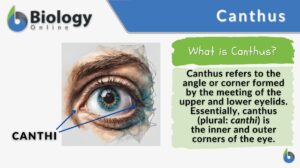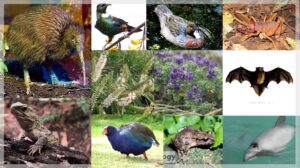
Canthus
n., plural: canthi
/ˈkænθəs/
Definition: The inner and outer corners of the eye
Table of Contents
Canthus Definition
The canthus refers to the corner or angle of the eye formed by the joining of the lower and upper eyelids. The canthus is a pivotal anatomical feature in biology, denoting the point where the upper and lower eyelids meet around the eye. This convergence forms two distinct canthi: the inner canthus (medial canthus) and the outer canthus (lateral canthus). The inner canthus is situated near the nose whereas the outer canthus is closer to the temple. The canthus plays a crucial role in protecting the eye by helping to distribute tears and prevent foreign particles from entering the eye. Additionally, the canthus contributes to the structural integrity of the eyelids and their coordinated movements, influencing aspects of vision and ocular health.
Etymology: The term “canthus” originates from the Greek word “kanthos,” referring to the corner of the eye.
Synonym: eye corner
Canthus Anatomy
The anatomy of the canthus is intricately tied to the structure of the eye and its surrounding features. There are two distinct regions of the canthus:
- Inner canthus or medial canthus, situated near the nose
- Outer canthus or lateral canthus, positioned near the ear
Essentially, the canthus represents the meeting point of the inner (medial) and outer (lateral) corners of the eye. However, the canthus is not merely a point of convergence. The canthus is associated with tissues and structures, including the canthal tendon, which connects the eyelids to the bony orbit.

Function Of The Canthus
The canthus is essential to the anatomy and function of the eye. Imagine if the eye lacks canthi or eye corners. The eye will likely be round and could take the shape or outline of the eyeball. If that happens, the eyes might not have an efficient protective mechanism against irritants. Also, the blinking mechanism may be altered.
Here are some of the functions of the canthus:
- The convergence of the eyelids at the corner of the eye allows tear distribution. The tears from the lacrimal glands can be evenly distributed with efficiency due to the presence of the canthi.
- The presence of the canthi enables an efficient blinking mechanism, which is essential for the eye’s ability to self-clean and maintain optimal moisture.
- The presence of distinct canthi somehow makes the eye not fully open or exposed to the environment, exposing only a portion that suffices an efficient vision while enabling the eye to rapidly close to protect the eye from external elements, such as dust, debris, and other foreign particles.
NOTE IT!
Canthi Of Animals
Some vertebrates have canthi that are more well-defined than the others. Humans and other mammals have well-defined canthus. In humans, for instance, the canthi would additionally aid in non-verbal communication and facial expressions. Carnivores, such as cats and dogs, also have a more pronounced canthus that aids in their predatory behavior. A well-defined pair of canthi contributes to improved binocular vision by allowing depth perception. This helps predators to judge the distance of their prey with higher precision. Other vertebrates may seem to lack canthi but they do if one looks closely. Their canthi, though, are not well-defined. Examples of such animals are some birds and reptiles. Fish also exhibit a variety of eye shapes and canthi depending on their habitat and behavior. The lack of prominent canthi in fish is an adaptation to the optical properties of water and helps optimize visual acuity and sensitivity to the motion in aquatic environments. The shape of the canthus can vary between species, and it contributes to their visual adaptations for hunting or navigating their environment.
Big Cats Have Eyes Designed For Hunting | Lions, Leopards, Tigers (by Love Nature):
References
- Smith, J. A. (2023). “The Anatomy and Physiology of the Canthus.” Journal of Ocular Sciences, 15(2), 45-58.
- Brown, M. K. et al. (2023). “Advancements in Ocular Health: Insights into Canthus Function.” Ophthalmology Today, 8(4), 112-120.
- Aristotle. (350 BCE). “De Sensu et Sensibilibus” [Classic Reference].
- Galen. (150 CE). “On the Natural Faculties” [Classic Reference].
©BiologyOnline.com. Content provided and moderated by Biology Online Editors.







